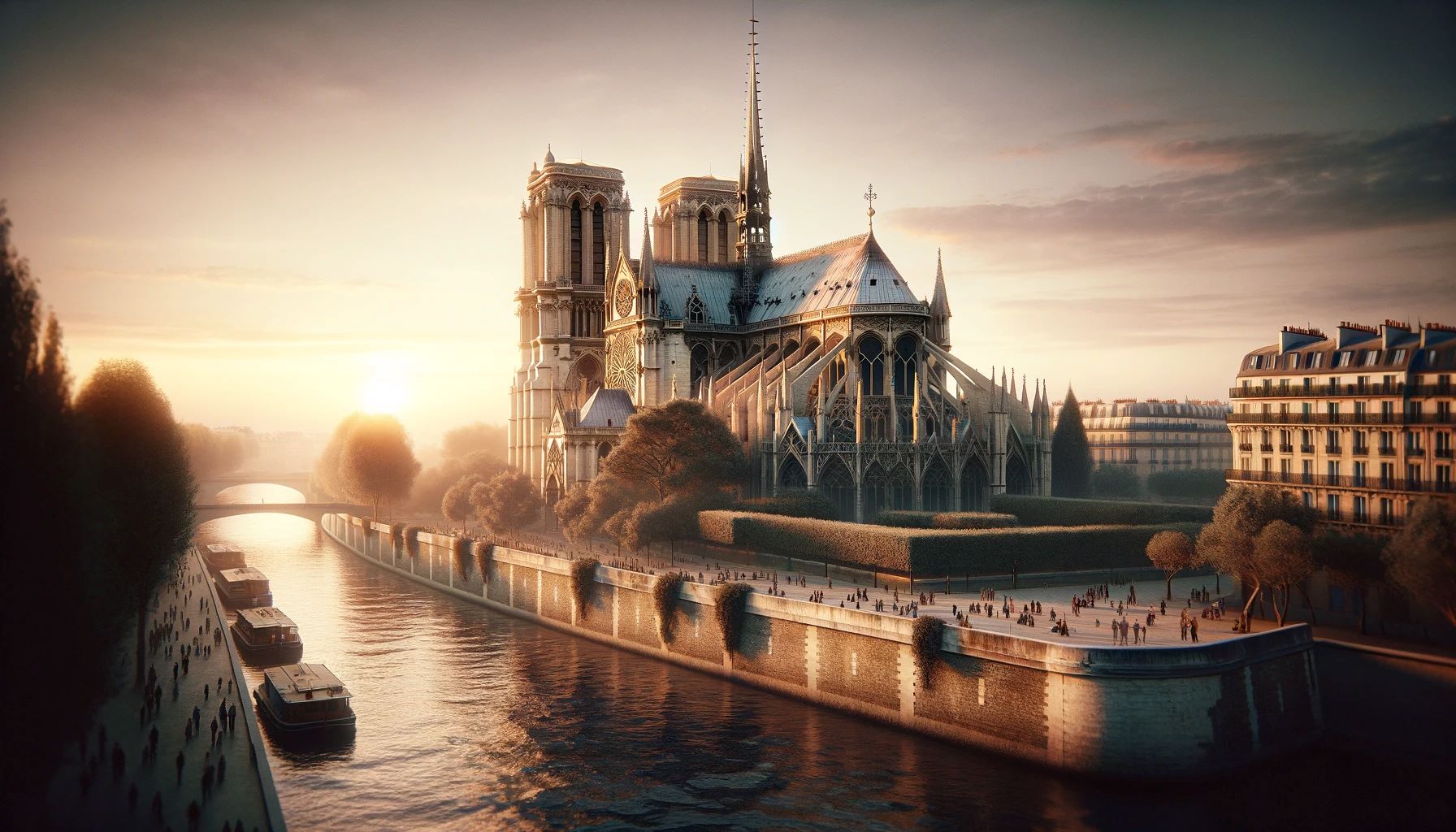Home>Arts and Culture>Why Is The Notre Dame Cathedral Important


Arts and Culture
Why Is The Notre Dame Cathedral Important
Published: February 18, 2024
Peter Smith, Editorial Director at Christian.net, combines deep insights into faith, politics, and culture to lead content creation that resonates widely. Awarded for his contributions to religious discourse, he previously headed a major organization for religious communicators, enhancing dialogue on faith's societal impacts.
Discover the significance of the Notre Dame Cathedral in arts and culture. Explore its historical and architectural importance in this insightful article.
(Many of the links in this article redirect to a specific reviewed product. Your purchase of these products through affiliate links helps to generate commission for Christian.net, at no extra cost. Learn more)
Table of Contents
Introduction
The Notre Dame Cathedral, a timeless symbol of Paris and a masterpiece of French Gothic architecture, holds a profound significance that transcends its physical presence. This iconic structure, with its awe-inspiring spires and majestic rose windows, has stood as a testament to human ingenuity and spiritual devotion for over eight centuries. Its enduring allure has captivated the hearts and minds of people from all walks of life, drawing millions of visitors each year to witness its grandeur and experience its profound historical and cultural resonance.
As we delve into the multifaceted importance of the Notre Dame Cathedral, we will unravel the intricate tapestry of its historical, architectural, and symbolic significance. From its storied past to its enduring legacy, the Notre Dame Cathedral continues to inspire wonder and reverence, serving as a timeless beacon of human achievement and spiritual aspiration.
Read more: Where Is The Notre-Dame Cathedral
Historical Significance
The historical significance of the Notre Dame Cathedral is deeply rooted in its rich and storied past, which spans over eight centuries. Construction of this architectural marvel commenced in 1163 and was completed in 1345, making it a living testament to the unwavering dedication and craftsmanship of countless artisans and builders. Throughout its existence, the cathedral has borne witness to a myriad of historical events, serving as a silent sentinel amidst the ebb and flow of time.
One of the most pivotal moments in the cathedral's history occurred during the French Revolution, when it faced the threat of desecration and destruction. Miraculously, the cathedral survived this tumultuous period, emerging as a resilient symbol of endurance and resilience. Its survival not only attests to the structural integrity of the building but also underscores its profound cultural and historical significance to the people of France and the world at large.
Moreover, the Notre Dame Cathedral has been a silent witness to numerous coronations, royal weddings, and significant religious ceremonies, further cementing its status as a cornerstone of French history and heritage. The cathedral's hallowed halls have echoed with the footsteps of monarchs, dignitaries, and countless pilgrims, each leaving an indelible mark on its illustrious legacy.
In 2019, the world watched in collective anguish as a devastating fire engulfed the cathedral, threatening to erase centuries of history and cultural heritage in a matter of hours. The outpouring of grief and solidarity from people around the globe underscored the cathedral's enduring significance as a symbol of human achievement and collective memory.
The historical significance of the Notre Dame Cathedral extends far beyond its architectural grandeur; it embodies the resilience, tenacity, and cultural identity of a nation. As a living testament to the triumphs and tribulations of the human spirit, the cathedral stands as a poignant reminder of the enduring power of history to unite and inspire generations to come.
Architectural Importance
The Notre Dame Cathedral stands as a paragon of architectural excellence, embodying the pinnacle of French Gothic design and engineering prowess. Its soaring spires, intricate flying buttresses, and ornate rose windows collectively represent a harmonious fusion of artistic vision and technical innovation. The cathedral's architectural significance extends beyond its aesthetic appeal, encompassing structural advancements that revolutionized medieval construction techniques.
At the heart of the cathedral's architectural splendor lies its innovative use of flying buttresses, a defining feature of Gothic architecture. These external masonry supports not only lend a sense of ethereal grace to the structure but also serve a crucial structural function, redistributing the immense weight of the vaulted ceilings and allowing for the inclusion of expansive stained glass windows. The interplay of light and space within the cathedral's interior, made possible by the flying buttresses, creates an atmosphere of celestial luminosity, evoking a profound sense of spiritual transcendence.
The intricate rose windows, with their kaleidoscopic hues and intricate tracery, stand as a testament to the ingenuity of medieval artisans. These masterpieces of stained glass artistry not only adorn the cathedral with resplendent beauty but also serve as a visual narrative of biblical stories and sacred symbolism. The interplay of light and color through the rose windows infuses the interior spaces with an ethereal glow, captivating the senses and inspiring contemplation.
Furthermore, the cathedral's imposing spires, reaching skyward with majestic grandeur, exemplify the vertical emphasis characteristic of Gothic architecture. These towering structures, crowned with ornate sculptures and intricate details, serve as a visual representation of humanity's aspiration towards the divine. The spires, along with the cathedral's imposing facade and sculpted portals, invite awe and reverence, beckoning visitors to behold the magnificence of human creativity and spiritual devotion.
The architectural importance of the Notre Dame Cathedral transcends its physical form, serving as a testament to the boundless ingenuity and artistic vision of the medieval craftsmen who brought this monumental edifice to life. Its enduring legacy continues to inspire architects, artists, and admirers of beauty and craftsmanship, reaffirming its status as a timeless masterpiece of architectural achievement.
Religious and Cultural Symbolism
The Notre Dame Cathedral transcends its role as a mere architectural marvel, embodying profound religious and cultural symbolism that resonates deeply with visitors and devotees alike. As a sacred sanctuary and a testament to human spirituality, the cathedral serves as a tangible expression of faith and devotion, weaving together a tapestry of symbolic elements that enrich its cultural significance.
At the heart of the cathedral's symbolism lies its role as a sacred space dedicated to the veneration of the divine. The soaring nave, adorned with intricate rib vaults and illuminated by the ethereal glow of stained glass, evokes a sense of celestial grandeur, inviting worshippers to contemplate the transcendent mysteries of faith. The sacred relics enshrined within the cathedral, including the Crown of Thorns and a fragment of the True Cross, serve as tangible links to the sacred narratives of Christianity, infusing the space with a palpable aura of reverence and spiritual significance.
Moreover, the cathedral's architectural elements are imbued with profound symbolic meaning, each contributing to the overarching narrative of religious devotion and salvation. The iconic gargoyles and grotesques that adorn the exterior of the cathedral, while serving a practical function in channeling rainwater away from the building, also carry symbolic significance as guardians warding off evil and protecting the faithful. The intricate sculptures and bas-reliefs that adorn the portals and facades of the cathedral depict scenes from scripture and Christian iconography, serving as visual allegories that convey timeless spiritual truths to all who behold them.
Beyond its religious symbolism, the Notre Dame Cathedral holds immense cultural significance as a living repository of France's artistic and historical heritage. The cathedral's role as a backdrop for significant national events, such as royal coronations and state ceremonies, underscores its enduring importance as a symbol of French identity and unity. The timeless allure of the cathedral has inspired countless artists, writers, and musicians, serving as a muse for creative expression and a source of national pride.
In essence, the Notre Dame Cathedral stands as a testament to the enduring power of faith, art, and cultural heritage. Its religious and cultural symbolism intertwines to form a rich tapestry of meaning, inviting visitors to contemplate the profound mysteries of human spirituality and the timeless legacy of artistic expression. As a living embodiment of faith and creativity, the cathedral continues to inspire and uplift all who are drawn to its hallowed embrace.
Restoration and Preservation Efforts
Following the devastating fire that engulfed the Notre Dame Cathedral on April 15, 2019, the world witnessed an outpouring of solidarity and determination to restore this iconic symbol of human achievement and cultural heritage. The catastrophic blaze, which ravaged the cathedral's roof and spire, served as a catalyst for an unprecedented global effort to undertake the monumental task of restoration and preservation.
In the immediate aftermath of the fire, a wave of support and pledges of financial assistance poured in from individuals, corporations, and governments around the world. The overwhelming response underscored the cathedral's profound significance as a cherished cultural treasure and a testament to human ingenuity. The outpouring of generosity and solidarity galvanized a collective resolve to embark on the arduous journey of rebuilding and restoring the cathedral to its former glory.
Central to the restoration efforts is the meticulous process of salvaging and preserving the cathedral's surviving architectural elements and priceless artifacts. Teams of skilled craftsmen, conservators, and experts in historical preservation have been tirelessly working to assess the structural integrity of the building and carefully catalog and safeguard its irreplaceable treasures. Every stone, sculpture, and stained glass window holds immense historical and artistic value, making the preservation efforts a painstaking yet essential endeavor to honor the cathedral's legacy.
The restoration project also encompasses a comprehensive assessment of the cathedral's structural stability and the implementation of innovative techniques to ensure its long-term preservation. Engineers and architects have been tasked with devising a meticulous plan to rebuild the cathedral's roof and spire, drawing upon historical blueprints, advanced technology, and time-honored craftsmanship to recreate these iconic features with unwavering attention to detail and authenticity.
Furthermore, the restoration efforts have sparked a renewed dialogue on the intersection of tradition and innovation in the preservation of cultural heritage. The process of rebuilding the Notre Dame Cathedral presents a unique opportunity to marry age-old craftsmanship with modern advancements in architectural conservation, ensuring that the cathedral continues to stand as a living testament to human creativity and resilience for generations to come.
As the restoration and preservation efforts continue to unfold, the Notre Dame Cathedral stands as a poignant symbol of hope and renewal, embodying the unwavering spirit of collective determination to safeguard our shared cultural legacy. The journey to restore this architectural masterpiece serves as a testament to the enduring power of human endeavor and solidarity, reaffirming the cathedral's timeless significance as a beacon of resilience and cultural heritage.
Read more: Who Insured Notre Dame Cathedral
Conclusion
In conclusion, the Notre Dame Cathedral stands as a timeless testament to human creativity, spiritual devotion, and cultural heritage. Its multifaceted importance encompasses a rich tapestry of historical, architectural, and symbolic significance that transcends the boundaries of time and place. From its enduring resilience in the face of adversity to its profound religious and cultural symbolism, the cathedral continues to inspire awe and reverence, serving as a beacon of human achievement and collective memory.
The cathedral's historical significance, spanning over eight centuries, bears witness to the triumphs and tribulations of the human spirit. It has weathered the tides of history, emerging as a resilient symbol of endurance and cultural identity. The architectural splendor of the Notre Dame Cathedral, characterized by its innovative use of flying buttresses, intricate rose windows, and soaring spires, represents a harmonious fusion of artistic vision and technical ingenuity. Its awe-inspiring design continues to captivate the imagination of visitors, reaffirming its status as a masterpiece of Gothic architecture.
Moreover, the cathedral's religious and cultural symbolism intertwines to form a rich tapestry of meaning, inviting contemplation of the profound mysteries of faith and the enduring legacy of artistic expression. As a living embodiment of faith and creativity, the cathedral continues to inspire and uplift all who are drawn to its hallowed embrace.
The restoration and preservation efforts following the 2019 fire have galvanized a global community in a collective resolve to safeguard this cherished cultural treasure. The outpouring of solidarity and generosity underscores the cathedral's profound significance as a symbol of human achievement and cultural heritage. The ongoing restoration project serves as a testament to the enduring power of human endeavor and solidarity, reaffirming the cathedral's timeless significance as a beacon of resilience and cultural heritage.
In essence, the Notre Dame Cathedral stands as a living testament to the enduring power of history, art, and human resilience. Its significance reverberates far beyond its hallowed walls, serving as a poignant reminder of the timeless values that unite humanity across generations. As the cathedral continues to inspire wonder and reverence, it remains an indelible symbol of human aspiration and the enduring legacy of cultural heritage.














